A survey of school nurse staffing in the school health services
There is a considerable gap between the health authorities’ recommended minimum norm for school nurse staffing and the actual figures at most schools in Norway.
Bakgrunn: Helsedirektoratet har utviklet anbefalte normtall for helsesøsterdekning i de ulike deltjenestene av helsestasjons- og skolehelsetjenesten. Det har hittil manglet data som gir oversikt over avstand til norm i barne-, ungdom- og videregående skole.
Hensikt: Hensikten med denne studien var å kartlegge helsesøsterbemanningen på den enkelte skole i Norge og evaluere denne opp mot anbefalte normtall og tilstedeværelse. Ved å analysere forskjeller mellom skoletrinn, fylker, skolestørrelse og kommunestørrelse ønsket vi å evaluere om helsesøsterdekningen i skolehelsetjenesten er dimensjonert slik at elevene har et faglig forsvarlig lavterskeltilbud.
Metode: Det ble gjennomført en tverrsnittstudie, ved hjelp av spørreskjema, til kommunene. Ikke-parametriske metoder ble brukt for å sammenligne helesøsterdekning opp mot skolestørrelse og kommunestørrelse. Kji-kvadrat tester ble brukt for å undersøke forskjeller mellom proporsjoner i ulike grupper.
Resultat: Bare 1,4 prosent av landets skoler hadde helsesøster til stede hver dag. Antall helsesøstre i barneskolen må økes med 125 prosent for å nå normtall. For ungdomsskolen må økningen være 34,4 prosent og for videregående skole 21,1 prosent. Avstand til norm økte med kommunestørrelse og skolestørrelse
Konklusjon: Skolehelsetjenesten er ikke bemannet i forhold til anbefalt norm for helsesøsterdekning. Tilbudet er ulikt i kommuner, bydeler og mellom skoler og kan ikke betegnes som et likeverdig lavterskeltilbud.
Introduction
In its development strategy for child health clinics and school health services, the Norwegian Directory of Health has worked out a proposal for a staffing norm (1). The proposed minimum norm for school nurse coverage in relation to students is based on a calculation of the time needed to perform professionally recommended tasks in the school health services. The recommended norm per full-time school nurse position is 300 students in primary schools, 550 in lower secondary schools and 800 in upper secondary schools.
The law states that all municipalities shall have “school health services in schools” (2). The regulations and guidelines for the child health clinic and school health services are developed in accordance with knowledge-based practice (3). A professionally based school health service may thus be understood as a service where the content is in accordance with such regulations and guidelines. The purpose of the service is to further psychical and physical health, good social and environmental conditions, and to prevent disease and injuries (4). The preparatory work for the Health and Care Services Act explores this intention. The service shall be a “drop-in”, “low-threshold service” in schools, where the school children may receive early assistance at the lowest possible level (5). Nationwide controls of the school health services showed that availability was low and varied considerably from place to place (6). Earlier, smaller, surveys from Oslo’s boroughs and from the ten largest cities in Norway show the same results. Staffing was far below the recommended norm in many locations (7-9).
In a knowledge review of school health services no systematic surveys were found dealing directly with staffing (10). Searches in various data bases confirm that school health services in general and the staffing situation in particular have not been much researched globally.
A few separate studies and other publications do exist that address staffing nationally and internationally: One American study reports that data on school health service staffing on a national level are essential for obtaining an overview of the resource effort in measures implemented by the school health services (11). The Norwegian Directorate of Health has pointed to the absence of such a national survey of staffing in the various part services, such as child health clinics, primary schools, lower secondary schools, upper secondary schools and health clinics for adolescents (1).
The Norwegian Institute for Urban and Regional Research refers to a positive effect of adequate staffing in the child health clinics and school health services. The institute concludes that municipalities with adequate school nurse coverage show a reduction in child protection measures due to an earlier implementation of support measures (12).
In several cross-sectional studies collaborating personnel in schools have been interviewed on the role of the school nurse (13-15). The results show that when school nurses are present in schools, the teachers’ time is freed to teach, and in some cases students and parents do not have to take time off to seek second line services. School nurses assess and deal with health related problems that get in the way of learning. In another study teachers express a wish for increased availability of school nurses in schools, as contributors to the social environment and to teaching (16).
Baltag & Levi have analysed the effect of various organisational models for the health services for school children based on data from 37 European countries (17). The Norwegian model with a low-threshold service in schools is described as good in that it provides services equally to all students, is efficient and of economic value. Another qualitative study with comparative design studies the students’ access to health services and compares schools with school nurse present full time or part time (18). The study shows that the students more frequently make contact for consultations where the school nurse is present daily than where the school nurse is present twice a week. The authors claim that this indicates an unmet need for health services in schools with low availability.
The purpose of this study was to map school nurse staffing in individual schools in Norway at one point in time in the whole country, and evaluate this against recommended norm figures and presence. By analysing variations between school class levels, counties, school size and municipality size, we wished to assess whether the school nurse coverage in the school health services is dimensioned in such a way that the students have access to a professionally based low-threshold service.
Method
Design
The simplest way of observing a number of observational units for comparison at one point in time is to perform a cross-sectional study (19,20). A cross-sectional study with electronic questionnaires was used to map health nurse staffing in school health services at one point in time in all counties.
Sample
The sample consisted of primary, lower secondary and upper secondary schools. In order to compare the number of students at each school with the norm figures for school nurse staffing (1), student figures were taken from the Primary schools’ information system (21) and Statistics Norway (SSB) (22).
Inclusion criteria:
Primary schools: 1.–7. Grades
Lower secondary schools: 8.–10. Grades
Public upper secondary schools: 1.–3. Grades
Total number of students more than 40
Exclusion criteria:
Schools with a different categorization of students, such as 1.–4. grades, or 1.–10. grades, are excluded as norm figures are not calculated for such schools. Private high schools do not report total number of students to the SSB, and are thus excluded.
In the smallest schools the norm figure may be met by having a school nurse present less frequently than every 14. day. Other issues than norm figures must in those cases be the basis of evaluating professionally justifiable availability of school health services. Schools with less than 40 students are consequently not included in the study.
The sample, after the above selections, consists of 2350 schools from 340 of the nation’s 428 municipalities. Population figures from the included municipalities are provided by the SSB.
Data collection
The information collected has not been collected on a nationwide basis earlier. Adapted, electronic questionnaires were developed for each municipality. The questionnaire form contained an overview of relevant schools in the municipality in accordance with the inclusion criteria. For each school there was a space to fill in for the school nurse position percentage including meetings, and a space for comments. The questionnaire was sent to the leader for the school health services in each municipality on March 8th 2015. Updated e-mail lists were provided by the Kommuneforlaget [Municipal publishing house]. For the three largest cities the questionnaires were sent to the cities’ boroughs. The comments were read and the position percentage adjusted according to the comments. Microsoft Access was used to send the questionnaires and for automatic registration of answers. The answers were checked using random testing and found to be correct. A reminder was sent to those who had not responded within the two weeks following the deadline.
Categories
School nurse coverage, defined as number of children per school nurse position, was analysed against school size and municipality size. School size was categorised in small, medium and large, divided into tertiles based on student figures at primary, lower secondary and upper secondary school levels respectively (primary school 0–143 students, 144–286 and 287–825, lower secondary school 0–232, 233–343 and 344–723 and upper secondary school 0–276, 277–572 and 573–2110). The municipalities, excluding Oslo, were categorised by population figures in small: = 5000, medium: 5000–10000 and large: =10000.
Ethics
Approved ethical guidelines based on the Helsinki Declaration (NEM 1992) were followed. The information collected in this study is available to each municipality’s inhabitants at, among other places, web sites. The study was reported to the Norwegian Social Science Data Services (NSD) 14.01.2015. The NSD responded that a formal application was not necessary, as no information appears that is in conflict with privacy protection guidelines. The data material in this study contains no singular mention of any person.
In order to adhere to the principle of providing adequate information regarding the purpose of the study (20), the respondents were given detailed information on the purpose of the study when the electronic questionnaire was sent to the municipalities.
Data analysis
School nurse coverage was reported as median and interquartile range due to skewed data. The Kruskal-Wallis (non-parametric one way ANOVA) test was used to test whether school nurse coverage varies with school size or municipality size. Chi-square tests were used to examine variations between proportions in the various groups. The deviance from the norm was defined as the variation between recommended norm figure for school nurse staffing and de facto school nurse coverage. Percentage-wise school nurse understaffing in the nation was calculated by deviation from the norm/norm figures* 100 for primary schools, lower secondary schools and upper secondary schools respectively. IBM SPSS statistics 22 was used for statistical analyses. The level of significance was set at p<0.05.
Results
200 of 340 municipalities (58 per cent) responded to the survey. Students per school nurse figures were collected for 69.3 per cent (1629 of 2350) of the schools. The response rate for counties varied from 22.9–93.4 per cent (p<0.001) (see table 1).
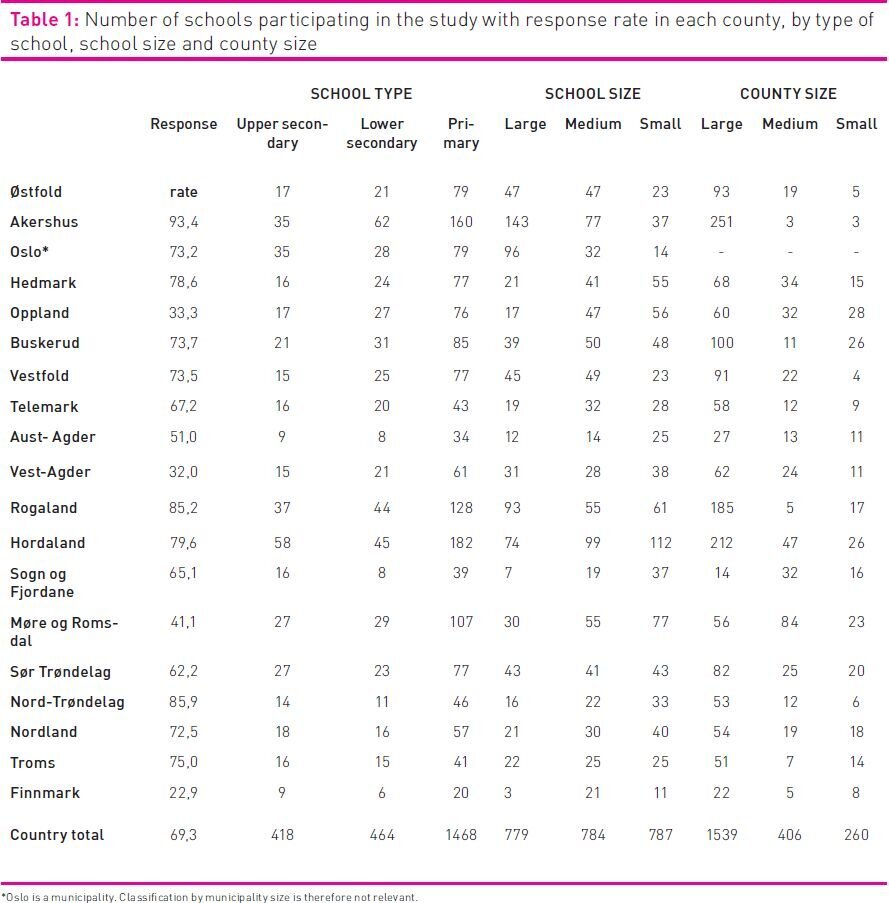
Median coverage rate in primary schools was 675 (interquartile range 531 –860) students per school nurse position. For the lower secondary school the median was 676 (531 –824) and for upper secondary school 969 (751 –1513). Norm figures for students per school nurse were met by 12.6 per cent of the schools. 2.5 per cent of the primary schools, 28.8 per cent of the lower secondary schools and 30.8 per cent of the upper secondary schools reported coverage rate that satisfied recommended norm figures. There were significant variations between counties with respect to students per school nurse in primary school (p<0.001), lower secondary school (p=0.005) and upper secondary school (p<0.001) (see figure 1).
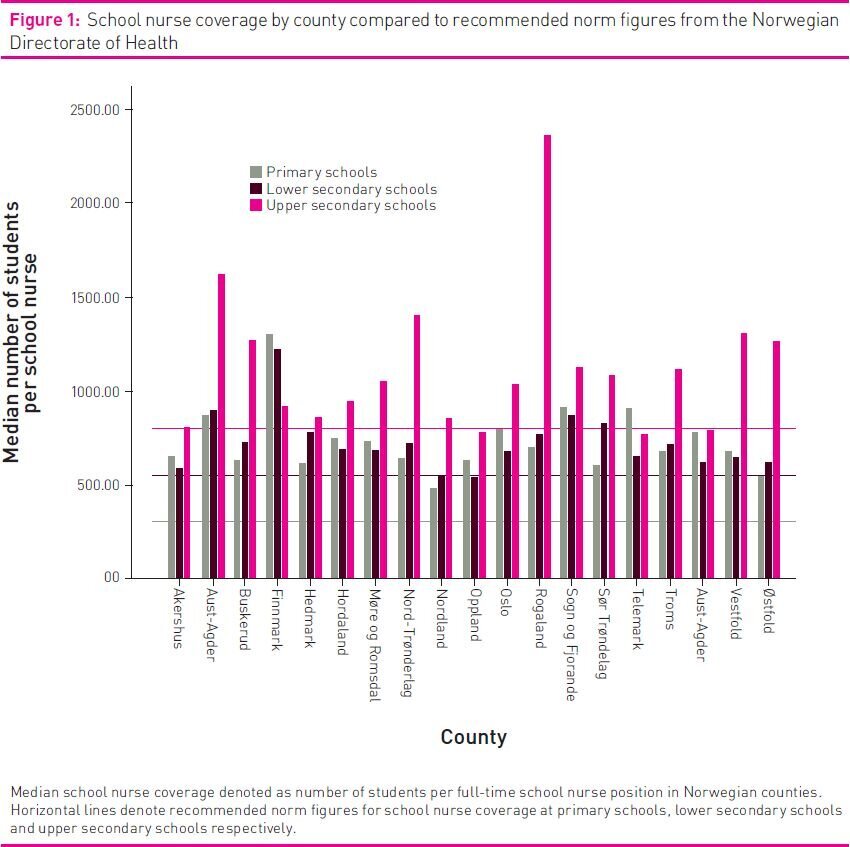
Median coverage rate varied according to municipality size. The number of children per school nurse position increased with the increase in municipality size at the primary and lower secondary school level. In the upper secondary schools there was no relation between degree of coverage and municipality size (see table 2).
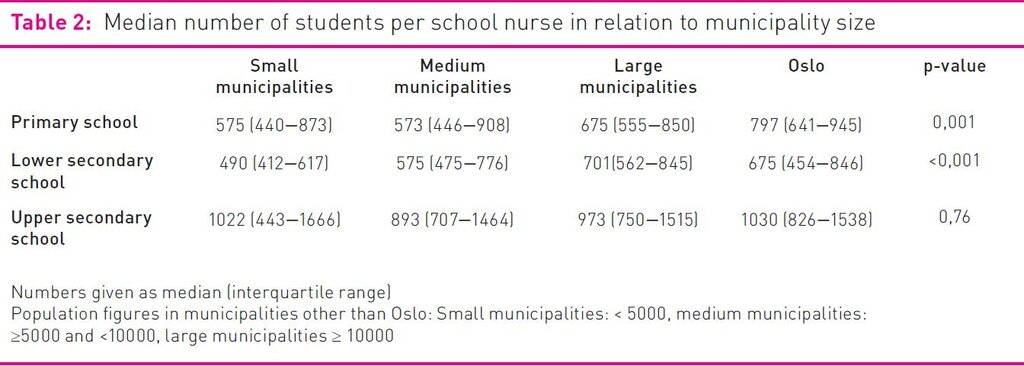
The number of students per school nurse increased with the increase in school size at all levels (see table 3).

1.4 per cent of the nation’s schools had a school nurse present every day (figure 2). Median staffing percentage for school nurses in Norwegian schools was 40 per cent, corresponding to a nurse being present two days a week (interquartile range 20 –50 per cent). Divided by type of school, median presence for primary schools was 30 per cent (interquartile range 20 –50 per cent), lower secondary schools 40 per cent (34 –60 per cent) and upper secondary schools 40 per cent (20 –80 per cent).
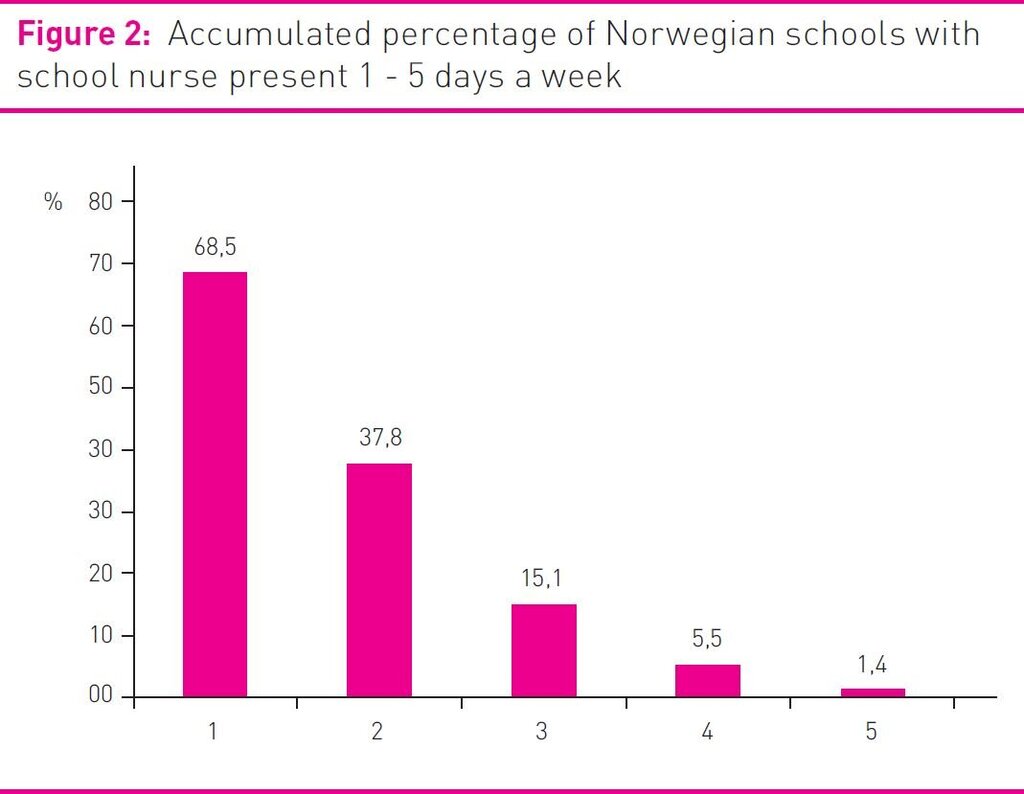
Discussion
The study showed that the deviation from recommended norm figures for school nurse coverage was substantial for all types of schools in Norway. The deviation was greatest in primary school, with no counties meeting the norm figure. Large schools were the furthest from the recommended norm and the school nurse staffing was lower the larger the municipality.
Low threshold
The low-threshold model with health services in school is assessed as being efficient and of economic value in a European context (18). This study shows that a full-time school nurse position in schools is very rare and that a 20-40 per cent position is common; this includes meeting time when the school nurse is not available to the students. The result causes some doubt as to whether we may call the school health services in Norway a low-threshold model where the students may get help early (5).
Children and adolescents are spontaneous, also when deciding to get advice and guidance. Meeting a closed door may make them more reluctant to contact the nurse again and they may not get the help they need. This is supported by research that points to that low availability may result in an unmet need for health services (18).
The Norwegian Ombudsman for Children and “voksne for barn” [“grown-ups for kids”] have talked to students from various schools in the country. The main advice from the students regarding the school health services is that there must be enough people working there and that the school nurse should be present every day (23,24). The students describe a low-threshold service as a place with no waiting lists, where someone is there when the students stop by. They also describe the service as being not all that available today: “’Come see me next week at two o’clock’ – that just doesn’t work, but that’s more or less what it’s like now” (23).
The study shows why there is a need for a local adaptation to the norm. A small primary school with 40 students will be able to meet the norm figure by having a school nurse present one day every two weeks. The service cannot then be considered low-threshold, open-door service for the children. It will also, most likely, be easier to get an overview of the student body in smaller schools and this may facilitate the planning of any follow-up. This means that the municipalities must make a thorough assessment of whether they are providing an adequate service to the students at each individual school.
Primary schools
Nationwide the number of school nurses must be increased by 125 per cent to reach norm figures. This finding is in conflict with a policy of early intervention, more prevention and a low-threshold service where people live (25-27). If problems are not dealt with when the child is in need of help, the challenges may increase and become needlessly large. Any measures may in such cases have to be much more extensive and the consequences more serious when help is late in arriving. Young adults with experience from child protection services, psychic health services, hospitals and correctional care report experiences of help arriving too late (28). Helmers and Dolonen carried out a survey among school nurses. The nurses reported that they due to time pressure were unable to do a professional job (29,30). They had to turn away distraught children at the door; they were too late in submitting reports to the child protection services and were unable to follow up children and families that they knew needed help. Being turned away, meeting a closed door, delays the implementation of necessary measures. This may have unfortunate consequences for the students’ health and care situation. Children and adolescents, teachers and parents, have in many cases not much of a chance to collaborate on the students’ wellbeing and learning because the school nurse is not present.
Small and medium sized municipalities were closer to the recommended norm figures for school nurse staffing in primary school than larger municipalities. This finding may be explained by there being more small schools in the smaller municipalities.
Lower and upper secondary schools
In order to reach the norm figures for school nurse staffing in lower secondary school the increase must be 34.4 per cent and for upper secondary school 21.1 per cent. Around a third of the counties were, however, close to the norm figure with regard to lower and upper secondary schools. Adolescents do to a greater extent communicate their own need for services than do smaller children. Ungdomsråd i Norge [Norwegian Youth Council] has had school health services on the agenda for several years. This was also marked by a national demonstration in spring 2014 when 600 young people met in front of the Storting [Parliament] demanding more school nurses (29). In Akershus the county politicians have approved an increase in staffing in the upper secondary schools, and at many of the county’s schools the school nurse is present all days (31).
The dispersion between counties with regard to the presence of school nurses in upper secondary schools was substantial. This may be explained by that the tasks, according to rules and regulations, are less specified there than in primary and lower secondary schools, where more tasks come under the heading “must-tasks” when it is a question of priorities.
Vaccination is one example of a “must-task” under the heading “prevent disease and injuries” (4). Vaccines are high priority, requested by the population, follow a recommended programme, and statistics on coverage rate are collected nationally. This most likely contributes to good vaccination coverage (32). In upper secondary school the school nurse shall “promote psychic and physical health” and “promote good social and environmental conditions” (4). How this should be done is not as concretely described as in the vaccination programme. The service shall nevertheless keep high professional standards and be in accordance with knowledge-based practice (3).
The proportion of immigrants in the population is increasing. Adolescents with immigrant background do to a lesser degree seek out the general health services, whereas they do use the school health services where these are available. This was reported in the adolescent part of the Oslo health study (UNGHUBRO). Here the questions addressed health habits, physical and psychological ailments, and disease (33). The study was carried out over several years and was a forerunner of the population health profiles (34). Lien pointed out in his analysis of the data that “immigrant adolescents do not need their own psychiatric service, but rather that the school health services are maintained as a low threshold service, particularly in upper secondary schools” (35). This train of thought addresses the notion that it is frequently better to deal with problems at the lowest possible professionally justifiable care level (LEON). Health promotion and preventative work should be performed in close proximity to the home environment (36,37).
There is little knowledge available on the effect of measures in the school health services. There is a need for more research in this field in order to understand relations between health, wellbeing and learning among children and adolescents. Basic data, such as this national survey of school nurse staffing in the individual school, contribute to visualising these relations. It will, however, be useful to gain knowledge on what school nurses do in schools with high coverage compared to in schools with lower coverage. What concretely does the presence of the school nurse mean to students and collaborating parties?
There is bipartisan agreement on a strengthening of health station and school health services. Yearly national reporting would contribute to ensuring that policy intentions are followed up by the municipalities (25 –27). This study indicates that there is a need for earmarking of funds and an approved minimum staffing, the way the Ombudsman for Children and Djupedalutvalget propose (23,40). Such a strengthening will enable a desired increase in staffing and help give children and adolescents countrywide a low-threshold service in school (5).
This is the first study to map school nurse coverage at individual schools in Norway, and evaluate this against recommended norm figures and presence. One of the strengths of this study is the high response rate (69.3 per cent). The total sample size is considerable even in the three counties with a response rate below 50 per cent. High response rates reduce potential sampling errors and increase the probability of reliability of the findings. There is, however, great variation among the counties, and we do not have data on what distinguishes those who responded from those who did not in each individual county. To a certain extent this weakens the generalizability of the study. The highest response rate of one county is 93.4 per cent. It is known that this county has had a particular emphasis on school nurses in upper secondary schools and this may have led to a higher staffing level compared to other counties. The deviation from the norm figures for school nurse staffing is the least in this county. This may, however, make this study over-estimate the figures for school nurse staffing nationally.
One limitation of the study is that the survey was done at one point in time and thus says nothing about the stability of the data over time. Measuring the coverage at several points in time would have yielded a more robust picture of the situation. The study does not consider any other factors than staffing which may be of importance in a professionally justifiable low-threshold service.
Conclusion
The question “Where is the school nurse?” is timely. This study shows that the national politicians’ intentions of early intervention, more prevention and easily accessible low-threshold services for children and adolescents in the school health services are not followed up by the municipalities. There is a considerable gap between the health authorities’ recommended minimum norm for school nurse staffing and the actual figures at most schools in Norway. This is particularly the case for primary schools where the effort according to the norm figures should have been the greatest. The result of the survey shows that children and adolescents receive very unequal school health services and that this is not justifiable. The staffing norm must be seen in relation to demographics and school size if the service is to be an equitable low-threshold service independently of where the students live.
References
1. Helsedirektoratet. Utviklingsstrategi for helsestasjons- og skolehelsetjenesten. 2010.
2. Lovdata. Lov om kommunale helse- og omsorgstjenester. 24.06 2011 [helse- og omsorgstjenesteloven]. Available from: https://lovdata.no/dokument/NL/lov/2011-06-24-30 (Nedlastet 17.06.2015).
3. Nortvedt MW, Jamtvedt G, Graverholt B, Nordheim LV, Reinar LM. Jobb kunnskapsbasert! En arbeidsbok. 4. ed: Akribe; 2012.
4. Forskrift om kommunens helsefremmende og forebyggende arbeid i helsestasjons- og skolehelsetjenesten. (2003).
5. Helse – og omsorgsdepartementet. Prop 90 L. Lov om kommuneale helse- og omsorgstjenester [helse- og omsorgstjenesteloven] (2010–2011).
6. Helsetilsynet. Fylkeslegenes felles tilsyn med skolehelsetjenesten 2010. Available from: https://www.helsetilsynet.no/no/Tilsyn/Landsomfattende-tilsyn/Fylkeslegenes-felles-2000-skolehelsetjenesten.
7. Oslo kommune, Helseetaten. Drøftingsnotat presentasjon av nøkkeltall for helsestasjons- og skolehelsetjenesten i Oslo til bruk i arbeidet med: effektiviseringsnettverk helsestasjons- og skolehelsetjenesten. 2014.
8. KS. ASSS-nettverk for Helsestasjons- og skolehelsetjenesten. Vedlegg: statistikk/diagrammer. 2014.
9. Fylkesmannen i Sør-Trøndelag. Kartlegging av ledelse i skolehelsetjenesten i Sør- Trøndelag. 2015.
10. Kunnskapssenteret. Effekter av skolehelsetjenesten på barn- og unges helse og oppvekstvilkår. Systematisk oversikt 2010.
11. Johnson KH, Bergren MD, Westbrook LO. The promise of standardized data collection: school health variables identified by states. J Sch Nurs. 2012;28(2): 95-107.
12. NIBR. Den vanskelige samhandlingen. Evaluering av forvaltningsreformen i barnevernet. Rapport 25/2011.
13. Baisch MJ, Lundeen SP, Murphy MK. Evidence-based research on the value of school nurses in an urban school system. J Sch Health. 2011;81(2):74–80.
14. Wang LY, Vernon-Smiley M, Gapinski MA, Desisto M, Maughan E, Sheetz A. Cost-benefit study of school nursing services. JAMA Pediatr. 2014;168(7):642–8.
15. Hill NJ, Hollis M. Teacher time spent on student health issues and school nurse presence. J Sch Nurs. 2012;28(3):181–6.
16 Winland J, Shannon A. School staff´s satisfaction with school health services. The Journal of school nursing: the official publication of the National Association of School Nurses. 2004;20(2):101–6.
17. Baltag V, Levi M. Organizational models of school health services in the WHO European Region. J Health Organ Manag. 2013;27(6).
18. Telljohann SK, Price JH, Dake JA, Durgin J. Access to school health services: differences between full-time and part-time school nurses. The Journal of school nursing: the official publication of the National Association of School Nurses. 2004;20(3):176–81.
19. Skog O-J. Å forklare sosiale fenomener. Gyldendal Akademisk 2004 s.72.
20. Polit DF, Beck CT. Essentials of nursing reaserch, appraising evidence for nursing practice. 8 ed. Philadelphia: Wolters Kluwer/Lippincott Williams & Wilkins; 2014 s 93 og 162–163.
21. Utdanningsdirektoratet. Grunnskolens informasjonssystem. Available from: https://gsi.udir.no/tallene.
22. Statistisk sentralbyrå. Videregående opplæring og annen videregående utdanning: SSB; udatert. Available from: http://www.ssb.no/utdanning/statistikker/vgu
23. Barneombudet. Helse på barns premisser. Barneombudets fagrapport 2013.
24. Voksne for barn. Lære for livet. 2014.
25. Helse– og omsorgsdepartementet. Stortingsmelding 34 Folkehelsemeldingen, God helse helles ansvar. 2012–2013.
26. Helse – og omsrgsdepartementet. Stortingsmelding 19 Folkehelsemeldingen, Mestring og muligheter. 2014–2015.
27. Helse – og omsrgsdepartementet Stortingsmelding 26 Fremtidens primærhelsetjeneste, Nærhet og helhet. 2014–2015.
28. Forandringsfabrikken. Available from: http://www.forandringsfabrikken.no (Nedlastet 17.06.2015).
29. Helmers A-KB, Dolonen KA. Helsesøstre slår alam. - Vi rekker ikke følge opp de som sliter. Sykepleien. 07.02.2013. Available from: https://sykepleien.no/2013/02/vi-rekker-ikke-folge-opp-de-som-sliter.
30. Helmers A-KB, Dolonen KA. Ett minutt er ikke nok Sykepleien 13.03 2014. Available from: https://sykepleien.no/2014/03/ett-minutt-er-ikke-nok.
31. Fylkesmannen I Akershus og Østfold. Fylkesrevisjonens kartlegging av de videregående skolene i Østfold. 2012.
32. Folkehelseinstituttet. Dekningsstatistikk for barnevaksiner 2014. Available from: www.fhi.no/artikler/?id=114769.
33. Folkehelseinstituttet. Ungdomsundersøkelser 2000–2004, 2008 og 2009. Available from: http://www.fhi.no/studier/regionale-helseundersokelser/ungdomsundersokelser-2000-2009.
34. Folkehelseinstituttet. Folkehelseprofiler 2015. Available from: http://www.fhi.no/helsestatistikk/folkehelseprofiler/finn-profil.
35. Lien L. Trenger noen som lytter. Sykepleien. 7/2011 (s. 72).
36. Forebygging.no. LEON-prinsippet. Available from: http://www.forebygging.no/Ordbok/L-P/LEON-prinsippet.
37. Store medisinske leksikon. LEON. Available from: https://sml.snl.no/helsetjeneste.
38. Egge H. «Du er ikke alene». Samtalegrupper som helsefremmende tiltak for skilsmissebarn. En grounded theory studie. [Master]: Nordic School of Public Health, Göteborg. 2012.
39. Kvarme LG, Helseth S, Sorum R, Luth-Hansen V, Haugland S, Natvig GK. The effect of a solution-focused approach to improve self-efficacy in socially withdrawn school children: a non-randomized controlled trial. International journal of nursing studies. 2010;47 (11): 1389-96.
40. Kunnskapsdepartementet NOU 2015:2 Djupedalsutvalget. Å høre til – virkemidler for et trygt psykososialt skolemiljø.







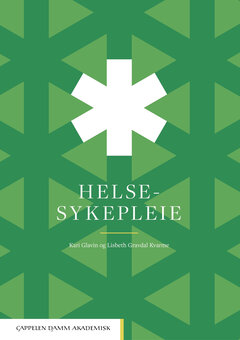


Comments